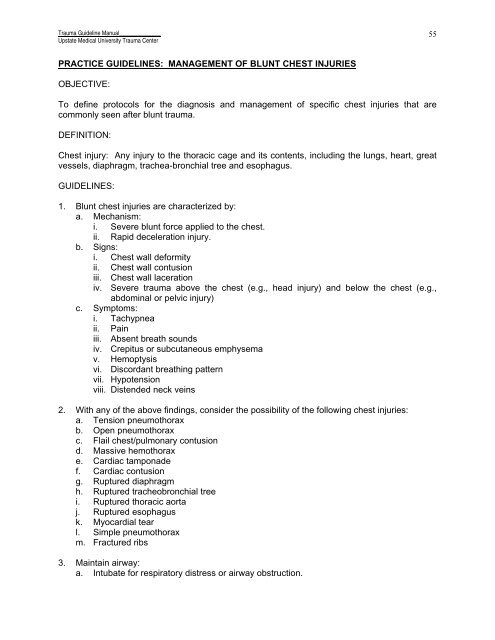Trauma Guideline Manual - SUNY Upstate Medical University
Trauma Guideline Manual - SUNY Upstate Medical University
Trauma Guideline Manual - SUNY Upstate Medical University
Create successful ePaper yourself
Turn your PDF publications into a flip-book with our unique Google optimized e-Paper software.
<strong>Trauma</strong> <strong>Guideline</strong> <strong>Manual</strong>______________<strong>Upstate</strong> <strong>Medical</strong> <strong>University</strong> <strong>Trauma</strong> Center55PRACTICE GUIDELINES: MANAGEMENT OF BLUNT CHEST INJURIESOBJECTIVE:To define protocols for the diagnosis and management of specific chest injuries that arecommonly seen after blunt trauma.DEFINITION:Chest injury: Any injury to the thoracic cage and its contents, including the lungs, heart, greatvessels, diaphragm, trachea-bronchial tree and esophagus.GUIDELINES:1. Blunt chest injuries are characterized by:a. Mechanism:i. Severe blunt force applied to the chest.ii. Rapid deceleration injury.b. Signs:i. Chest wall deformityii. Chest wall contusioniii. Chest wall lacerationiv. Severe trauma above the chest (e.g., head injury) and below the chest (e.g.,abdominal or pelvic injury)c. Symptoms:i. Tachypneaii. Painiii. Absent breath soundsiv. Crepitus or subcutaneous emphysemav. Hemoptysisvi. Discordant breathing patternvii. Hypotensionviii. Distended neck veins2. With any of the above findings, consider the possibility of the following chest injuries:a. Tension pneumothoraxb. Open pneumothoraxc. Flail chest/pulmonary contusiond. Massive hemothoraxe. Cardiac tamponadef. Cardiac contusiong. Ruptured diaphragmh. Ruptured tracheobronchial treei. Ruptured thoracic aortaj. Ruptured esophagusk. Myocardial tearl. Simple pneumothoraxm. Fractured ribs3. Maintain airway:a. Intubate for respiratory distress or airway obstruction.
















